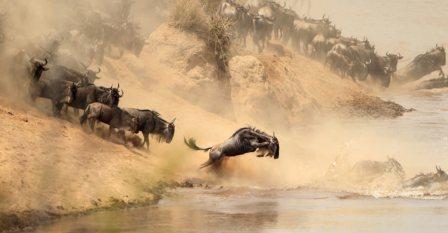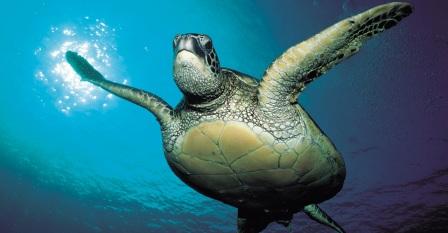
By Wendy Worrall Redal
Watching the planet's animals in motion offers a front-row view on an age-old drama where the marvels of adaptation are on stage. Each year, thousands of species take to the seas, skies and terrestrial thoroughfares, traveling from one habitat to another in search of water, food or breeding grounds. Their movements may be relatively limited, from timbered valleys to alpine heights, or massive, from one hemisphere to another. Experiencing the wonder of a migration is a thrill for nature travelers -- here are five opportunities to witness some of the planet's most remarkable wildlife spectacles.
Millions on the Move: The Legendary Serengeti
The greatest show on earth isn't found under a big top, but under a big sky: an East African sky, to be precise. Twice each year, the Serengeti Plains are darkened by nearly two million animals in on the move. Enormous herds of wildebeest stream in columns from Kenya's Maasai Mara into Tanzania's Serengeti National Park, hungry for the new grass that springs up during the seasonal rains.

Dust clouds rise as they clatter over the savanna in a din of grunts, bleats and pounding hooves. The wildebeest are accompanied by hundreds of thousands of zebra and Thomson's gazelle, and behind them, a phalanx of felines eager to feast on the young and weak members of the herds. There is no greater spectacle of predator and prey than that which unfolds in this ancient circle of life during Africa's Great Migration.
Pacific Paddlers: Gray Whales Go the Distance
The Pacific gray whale logs thousands of miles at sea each year, returning each winter to Mexico where wildlife lovers can encounter them at close range, often at arm's length. The gray whale's journey from its summer feeding grounds in Alaska to its breeding grounds in South Baja is the longest mammal migration on earth, an annual round trip of up to 14,000 miles along the coast of North America, where they are often visible from shore.
By March, hundreds of gray whales have returned to the sheltered waters of San Ignacio Lagoon, where their young are born each spring. Friendly whales often approach excursion boats; mothers frequently bring their offspring right up to the gunwales, eager to show them to human admirers. Grays are enormous, up to 45 feet long and weighing 30 to 40 tons. Watching them spout, spy-hop and breach provides some of nature's most delightful entertainment.
Mexico's Sea Turtles: From Sand to Sea and Back
Farther down Mexico's west coast on the beaches of Oaxaca, the migratory wonders move from mighty to miniscule. Here each fall, tiny olive ridley sea turtles hatch by the light of the moon. Just an inch and a half long and weighing less than an ounce, the babies emerge from buried nests and scurry en masse over the sand to the protection of the sea.

A pelagic species, they spend most of their lives in the open ocean, returning each summer to their breeding grounds along the Pacific coast of southern Mexico and Central America. Females arrive together by the hundreds to lay their eggs on the beach. The concentrated nesting pattern makes the turtles, already endangered by habitat loss and commercial fishing, highly susceptible to poaching. Sea turtle ecotourism adventures offer a chance to learn about turtle conservation and assist with beach patrol to protect nesting turtles and hatchlings.
Bears & Belugas: White Wanderers of the North
Churchill, Manitoba becomes a major destination for wildlife lovers in late autumn and again in summer, as visitors time their arrival with that of two of the Arctic's most charismatic residents: polar bears and beluga whales.
By early November, several hundred polar bears gather on the shore of Hudson Bay outside town, waiting for freeze-up when they can venture onto the ice and start hunting. The Arctic's top carnivore, polar bears cover hundreds of miles annually in their quest for seal meat as they migrate across huge expanses of tundra, pack ice and ocean.
Another northern denizen, the beluga whale, congregates at the mouth of the Churchill River in summer. Beluga means "white one" in Russian, and these rotund small whales with smiling faces look a bit like Casper the Friendly Ghost. They are highly sociable, gathering by the thousands each June in estuaries and shallow inlets where they feast on migrating fish. Mothers birth their young, who are born dark gray, in the same calving grounds year after year. Visitors in Zodiac rafts get an eye-level view of the curious, vocal cretaceans till ice begins to clog the river by mid-autumn, when belugas return to the sea.

Wildlife Migrations are Threatened: See Them Now
Many of the world's long seasonal migrations are under duress or even disappearing. Threatened by largely human-generated impacts including habitat loss, physical obstructions and climate change, migratory species are finding it more stressful to make the journeys that have been part of their annual rhythms for millennia. As you travel to watch animals on the move, learn more about why migrations matter and what you can do to help protect them.